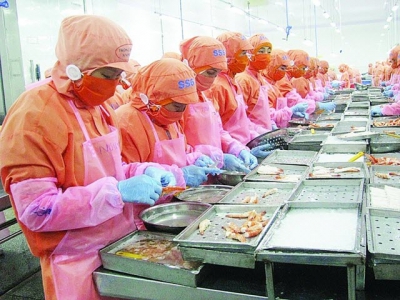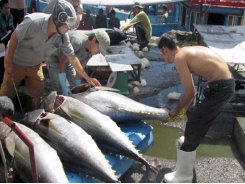Seafood exports gained momentum after Covid-19 pandemic

The Covid-19 pandemic has caused a significant drop in Vietnam's seafood exports since the beginning of the year. However, thanks advantages and competitiveness, seafood exports in the post-Covid-19 period were forecasted to have many opportunities to break through, compensating for previous losses.
The seafood industry aims to export US$10 billion in 2020. Photo: N.Thanh
Export value decreased by 10%
A report by the Department of Agricultural Product Processing and Market Development (MARD) showed that the seafood export value in the first four months of the year reached US$2.18 billion, down 10% compared to the same period in 2019. By the end of the first quarter of 2020, Japan, the US, the EU and China were the top four import markets of Vietnam's seafood, accounting for 57.69% of the total export value. The market getting the strongest increase in seafood export value was Russia with an increase of nearly 22%, reaching US$26.41 million.
In the domestic market, at the beginning of April, the price of raw shrimp in Bac Lieu decreased by VND10,000-20,000 per kilogram depending on size, but it recovered again at the end of the month due to the supply shortage. Currently, the price of shrimp has ranged from VND90,000 - 180,000 per kilogram depending on type and size. Additionally, since the beginning of April, the domestic pangasius material market in the Mekong Delta has been quiet due to the decline in export orders from many markets because of the Covid-19 pandemic.
The import value of fishery products in April was estimated at US$136 million, bringing the total value of imported seafood in the first four months to US$545 million, down 2.9% compared to the same period in 2019. Sources of seafood imports in the first three months this year were mainly from India (accounting for 14.9%); Norway (10.9%); Taiwan (9.1%); Japan (9%) and Indonesia (8.9%).
"China, the largest market for Vietnamese pangasius, has not yet fully recovered. The wholesale price of pangasius in the Mekong Delta decreased by VND500 per kilogram compared to the previous month, at around VND18,000 per kilogram for pangasius type I (700-900g per fish). Demand for raw fish in the market was low. Large companies hardly got pangasius from outside but mainly in their link system," said a representative of the Department of Agricultural Product Processing and Market Development.
Regarding seafood export, according to the Ministry of Industry and Trade, in the first months of this year, the rate of orders delivered normally under signed contracts accounted for 30-50% only; but the percentage of orders delayed and stopped or canceled by customers was high (20-40% and 20-30%, respectively). Especially in the EU market, most shrimp orders were postponed or canceled. It was difficult to sign new orders, especially for small and medium-sized businesses, which have had no new orders in the second and third quarter.
The Import and Export Department (Ministry of Industry and Trade) forecasted that Vietnam's seafood exports in May would continuously be affected by the Covid-19 pandemic. However, the impact level would be lower than in April when many countries began to relax the blockade.
Many opportunities after Covid-19
Currently, the Covid-19 pandemic has been gradually better controlled in countries around the world. Mr. Truong Dinh Hoe, General Secretary of Vietnam Association of Seafood Exporters and Producers (VASEP) said despite the impact of the Covid-19 pandemic in the past two months, Vietnam's fisheries sector had many opportunities to adapt, recover and develop in the new period.
"Aquatic production countries that compete with Vietnam, such as India and Ecuador, have blockades against the pandemic, reducing up to 50% of production and export. Indonesia, the Philippines and Thailand have also reduced about 30%. These countries will have significant delays over Vietnam in terms of recovering production after the pandemic to maintain the world's seafood supply,” said Hoe.
According to the Director General of the Directorate of Fisheries (MARD) Tran Dinh Luan, some countries like China and South Korea have basically controlled the disease. In the coming months, the demand for importing pangasius and other aquatic products will probably stabilize as the previous years.
“Notably, it is forecasted that after the EU market recovers, Vietnam would have preferential advantages from the Vietnam-EU Free Trade Agreement (EVFTA). Especially, we have a tax on shrimp products that India, Thailand or other countries cannot compete with,” said Luan.
The head of the Directorate of Fisheries said in the future, the Directorate of Fisheries would closely follow production to make adjustments in accordance with the reality of the disease and weather, and direct localities to strengthen production links from people to businesses in the chain of production–purchasing–processing–consumption of products to get the supply – demand balance.
The General Secretary of VASEP proposed the Prime Minister and ministries to facilitate and support seafood enterprises to develop market and conduct R&D in the new context; promote the EVFTA to take effect as soon as possible, so that businesses can take advantage of increasing seafood consumption in the EU market before comparative advantages with some competing exporting countries. In addition, in the long run, Mr. Truong Dinh Hoe proposed to the Government to research and develop an investment strategy for agro-fishery trade in border areas to sustainably develop the Chinese market; study how to organize Vietnamese aquatic product distribution centers to supply goods regularly and stably for demand in Chinese border provinces.
Có thể bạn quan tâm
Phần mềm

Phối trộn thức ăn chăn nuôi

Pha dung dịch thủy canh

Định mức cho tôm ăn

Phối trộn phân bón NPK

Xác định tỷ lệ tôm sống

Chuyển đổi đơn vị phân bón

Xác định công suất sục khí

Chuyển đổi đơn vị tôm

Tính diện tích nhà kính

Tính thể tích ao hồ



 Canned tuna exports increase thanks to rising demand
Canned tuna exports increase thanks to rising demand  Local tuna exports endure drastic downturn
Local tuna exports endure drastic downturn